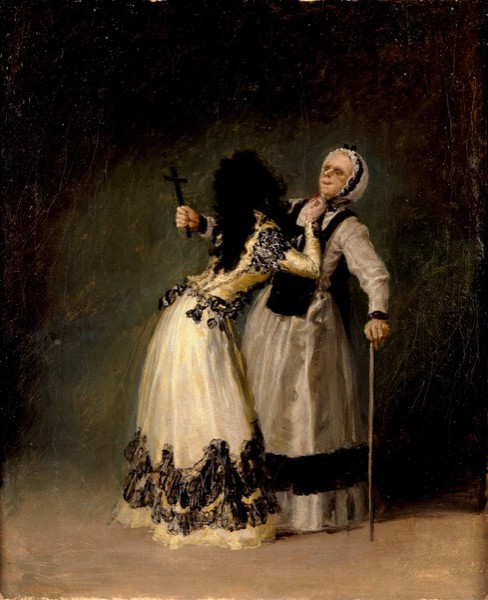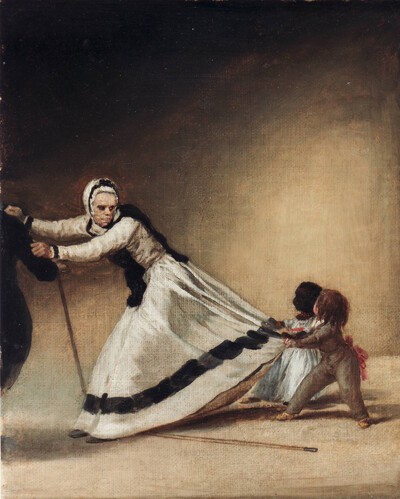- Cronología
- 1795
- Ubicación
- The Prado National Museum. Madrid, Madrid, Spain
- Dimensiones
- 30.7 x 25.4 cm
- Técnica y soporte
- Oil on canvas
- Reconocimiento de la autoría de Goya
- Documented work
- Titular
- El Prado National Museum
- Ficha: realización/revisión
- 21 Jun 2010 / 13 Jun 2023
- Inventario
- (P07020)
- Otros títulos:
-
The Duchess of Alba and her Duenna (La duquesa de Alba y su dueña)
The Duchess of Alba, Startling “the Sanctimonious”, her Maid (La duques de Alba, asustando a la Beata, su criada de cámara)
Goya año 1795 ("Goya, 1795", incised in the lower right-hand corner).
Luis Berganza, son of Tomás Berganza, the Duchess of Alba's administrator and one of the inheritors in her will, became the new owner of this canvas and its companion piece, "The Sanctimonious" with Luis de Berganza and María de la Luz. The work remained the property of this family's descendants until it was sold at Sotheby's in 1985. It was bought by the Spanish state, which acquired the work, by right of first refusal, for the Prado Museum.
When Goya painted this canvas he was fifty years old, and had only recently recovered from the illness which left him deaf. During his convalescence from this illness, spent in Cádiz, Goya made a series of small-scale cabinet paintings. These afforded him an opportunity to express himself freely in an artistic arena outside that of official, academic painting. Once he had returned to Madrid, the artist carried on working along the same lines as in those highly personal paintings produced during his seclusion. This same freedom of expression can be appreciated in the portraits he painted during this period of members of Madrid's aristocracy, among which are this work and its companion piece, "The Sanctimonious" with Luis de Berganza and María de la Luz.
The close relationship between Goya and the Duchess of Alba, whom he painted on several occasions, meant that the artist enjoyed access to the private sections of the palace, located in Madrid's Calle del Barquillo. This oil painting, which was made when the duchess was thirty-three years old, captures the moment when she attempts to frighten her elderly maid, Rafaela Luisa Velázquez, with a small red object. The old woman wards her off with the crucifix she holds in her hand. The maid was known as "the Sanctimonious" ("la Beata") thanks to her piety and devotion to prayer, which also seem to have made her the target of many jokes at the palace. In this work, Goya achieves an unusual, intimate portrait of the Duchess of Alba which manages to capture something of her rather irreverent character.
In terms of its style and subject matter, this portrait can be considered a prelude to the so-called Sanlúcar Album, Album A, which Goya made in 1796 during his stay in Cádiz. The Duchess of Alba and "the Sanctimonious" anticipates some of the stylistic characteristics of those drawings, as well as the importance they give to the human figure and the total absence of any description of the surrounding space.
-
De Greco á Picasso. Cinq siècles d’art espagnolMusée du Petit PalaisParís1987from October 10th 1987 to January 3th 1988cat. 101
-
GoyaLa Lonja, Torreón Fortea y Museo Pablo GargalloZaragoza1992consultant editor Julián Gállegocat. 23
-
Goya. El Capricho y la Invención. Cuadros de gabinete, bocetos y miniaturasMuseo Nacional del PradoMadrid1993from November 18th 1993 to February 15th 1994. Exhibited also at the Royal Academy of Arts, London, March 18th to June 12th 1994 and The Art Institute of Chicago, Chicago, July 16th to October 16th 1994, consultant editors Manuela B. Mena Marqués and Juliet Wilson-Bareaucat. 64
-
GoyaNationalmuseumStockholm1994consultant editors Juan J. Luna and Görel Cavalli-Björkman. From October 7th 1994 to January 8th 1995cat. 17
-
Goya. 250 AniversarioMuseo Nacional del PradoMadrid1996consultant editor Juan J. Luna. From March 29th to June 2nd 1996cat. 86
-
Goya. La imagen de la mujerMuseo Nacional del PradoMadrid2001from October 30th 2001 to February 10th 2002. Exhibitied also at the National Gallery of Art, Washington, March 10th to June 2nd 2002, consultant editor Francisco Calvo Serrallercat. 33
-
Goya luces y sombrasCaixaForumBarcelona2012consultant editors José Manuel Matilla and Manuela B. Marqués. From March 16th to June 24th 2012cat. 15
-
Madrid2017
-
La Duquesa de Alba y Goya. Estudio biográfico y artísticoMadridBlass1928p. 190
-
L'œuvre peint de Goya. 4 volsParís1928-1950p. 216, cat. 180
-
Vie et ouvre de Francisco de GoyaParísOffice du livre1970p. 171, cat. 352
-
BarcelonaPolígrafa1970vol. I, p. 298 cat. 368
-
L’opera pittorica completa di GoyaMilanRizzoli1974nº 284
-
Francisco de Goya, 4 vols.ZaragozaCaja de Ahorros de Zaragoza, Aragón y Rioja1980-1982vol. II, p. 123
-
Goya. Arte e condizione umanaNaplesLiguori editore1990il. 73
-
Goya. El capricho y la invención. Cuadros de gabinete, bocetos y miniaturasMadridMuseo del Prado1993pp. 260, 261 y 262 (il.)
-
Goya. 250 AniversarioMadridMuseo del Prado1996pp. 177 (il.), 363 y 364
-
Goya, la imagen de la mujerMadridMuseo Nacional del Prado y Fundación Amigos del Museo del Prado2001pp. 184 y 185 (il.), cat. 33
-
ZaragozaGobierno de Aragón y Fundación Bancaria Ibercaja2017p. 130

